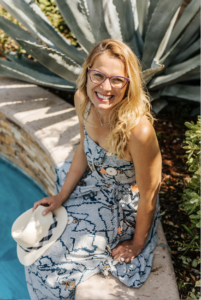Why You Should Choose A Natural Sunscreen
I love the sun. I’m a California girl with olive skin. When things are out of whack with my body, I experience low vitamin D levels, low energy, and a propensity toward depression.
The sun helps me. It nourishes me. And it nourishes you, too.
But protection is important. While I want you to get into the sun for a bit each day, it’s important to protect our skin from the damaging effects of UV rays. I prefer to use hats and gauzy clothes to cover up, but sunscreen is often a necessity. And we want to choose a good one!
There’s no question that proper sun protection is needed for skin health, but how often are you checking if the ingredients in that sunscreen are equally as safe?
In today’s article, we’re going to explore the reasons we need sunscreen, the concern with chemical sunscreens, and why a natural, non-chemical sunscreen is better for your skin and overall health.
WHY DO WE NEED SUNSCREEN?
Sunscreen is recommended to protect us from the sun’s UV radiation. That UV radiation is divided into 3 main groups: UVA rays, UVB rays, and UVC rays. The American Cancer Society provides important information about the breakdown of these rays:
- UVA rays have the least energy among UV rays. These rays can cause skin cells to age and can cause some indirect damage to cells’ DNA. UVA rays are mainly linked to long-term skin damage such as wrinkles, but they are also thought to play a role in some skin cancers.
- UVB rays have slightly more energy than UVA rays. They can damage the DNA in skin cells directly, and are the main rays that cause sunburns. They are also thought to cause most skin cancers.
- UVC rays have more energy than the other types of UV rays. Fortunately, because of this, they react with ozone high in our atmosphere and don’t reach the ground, so they are not normally a risk factor for skin cancer.
The strength of the UV rays reaching the ground depends on several factors, such as time of day, season of the year, distance from the equator, altitude, clouds, reflection off surfaces, and contents of the air.
So, the amount of UV exposure a person gets depends on the strength of the rays, the length of time the skin is exposed, and whether the skin is protected with clothing or sunscreen.
With that baseline information about UV rays, let’s jump to choosing sunscreen!
WHAT TO LOOK FOR IN CHOOSING A SUNSCREEN
The Skin Cancer Foundation provides a great outline for what to look for when choosing a sunscreen:
- Broad spectrum: Protects your skin from both UVA and UVB rays.
- SPF 15: Ideal for every day, occasional exposure, like walking your dog or driving to work.
- SPF 30 or higher: Necessary for extended outdoor activities, like distance running, hiking, swimming, or working.
Now that you’re armed with broad spectrum protection in SPF 15 or 30, let’s move on to the ingredients you’ll want to look out for!
THE CONCERN WITH CHEMICAL SUNSCREENS
The term ‘chemical-free sunscreens’ is commonly used to describe ‘physical’ or ‘mineral’ sunscreens, those that use the minerals zinc oxide and/or titanium dioxide as their only active ingredients. Conversely ‘chemical sunscreens’ use only non-mineral, or chemical, active ingredients such as oxybenzone, oxtinoxate, and octisalate. (1) According to publicly available scientific research, the most worrisome sunscreen active ingredient is oxybenzone. It is readily absorbed through the skin and the Centers for Disease Control and Prevention found it in nearly all Americans, with higher levels in those who report applying sunscreen (2). Oxybenzone causes allergic skin reactions, behaves like an endocrine disruptor, and is potentially of greater harm to children (3).Four studies published in 2020 further support previous findings that oxybenzone can act as an endocrine disruptor and may increase the risk of breast cancer and endometriosis (4).
If you’re interested in learning more about other chemicals and their negative health effects, check out this article from the Environmental Working Group (EWG).
MINERAL SUNSCREENS & ZINC OXIDE
Zinc oxide is one of only 17 active ingredients currently approved by the FDA for use in sunscreens. Unlike chemical sunscreens, zinc oxide particles sit on the outermost layer of your skin where they scatter, absorb, and reflect UV rays. Zinc oxide is unique among sunscreen ingredients in that it is truly a broad-spectrum blocker, protecting from UVA, UVB, and even UVC. (5)
While zinc oxide can be a health risk if inhaled, this is not a concern with cream and lotion-based sunscreens. (6)
I particularly like mineral-based sunscreens like this one.
And this one.
Credo Beauty is my favorite site for all things clean. I’m not sponsored and I don’t have an affiliate account. I just like them.
Before you have to ask, your own mineral sunscreen is probably just fine!
Remember, hats and long sleeves can do a long way too. Use sunscreen on your neck and hands, the places a woman’s age tends to show up first. Ugh 🙂
Now that you’re empowered with information about UV rays, chemicals to avoid, broad-spectrum protection and SPF, you can choose the best mineral sunscreen for your needs. The EWG has a great Sunscreen Guide filled with safe and healthy recommendations that will provide both broad spectrum protection and ingredients that pose fewer health concerns!
SOURCES
1- “The Difference in Physical vs. Chemical Sunscreens.” Babo Botanicals, https://www.babobotanicals.com/blogs/news/the-difference-in-physical-vs-mineral-sunscreens.
2-4. Sunscreens, EWG’s Guide to. “EWG’s Guide to Safer Sunscreens.” EWG, https://www.ewg.org/sunscreen/report/the-trouble-with-sunscreen-chemicals/.
5,6 “Zinc Oxide Sunscreens, Nanoparticles and Clear Zinc: Badger Balm.” BADGER, https://www.badgerbalm.com/pages/zinc-oxide-nanoparticles-clear-zinc-sunscreens.






